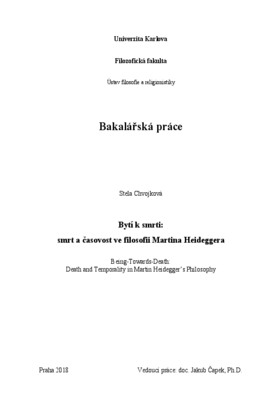Bytí k smrti: smrt a časovost ve filosofii Martina Heideggera
Being-Towards-Death: Death and Temporality in Martin Heidegger's Philosophy
bakalářská práce (OBHÁJENO)

Zobrazit/
Trvalý odkaz
http://hdl.handle.net/20.500.11956/103730Identifikátory
SIS: 198927
Kolekce
- Kvalifikační práce [24521]
Autor
Vedoucí práce
Oponent práce
Švec, Ondřej
Fakulta / součást
Filozofická fakulta
Obor
Filozofie
Katedra / ústav / klinika
Ústav filosofie a religionistiky
Datum obhajoby
4. 9. 2018
Nakladatel
Univerzita Karlova, Filozofická fakultaJazyk
Čeština
Známka
Výborně
Klíčová slova (česky)
Heidegger|smrt|konečnost|bytí k smrti|autenticita|úzkostKlíčová slova (anglicky)
Heidegger|death|finitude|being-towards-death|authenticity|anxietyTato bakalářská práce si klade za cíl předvést komplexní analýzu koncepce smrti a bytí k smrti ve filosofii Martina Heideggera, zejména v Bytí a čase. Analýza nejprve odmítá běžný způsob porozumění smrti a ukazuje tak, čím smrt být nemůže. Potom se zabývá Heideggerovou definicí smrti jako význačné možnosti pobytu, která může být uchopena pouze skrze vztah k vlastnímu konci. Snaží se poukázat na důležitost role, kterou hraje smrt a jistota o vlastní konečnosti v ontologii pobytu, a to jak sama o sobě, tak jako základ autentického a neautentického modu existence. Závěrečná část předkládá možné řešení problému přechodu mezi neautenticitou a autenticitou a zabývá se také ontologickou pozicí úzkosti.
This bachelor thesis aims to present a complex analysis of the conception of death and being- towards-death in the philosophy of Martin Heidegger, especially in Being and Time. The analysis starts with showing what death can not be by rejecting the prevailing understanding of death. Then it deals with the way Heidegger defines death as the specific possibility of Dasein, which can only be understood from the relationship to one's own end. It points to the importance of the role that death and certainty of one's finitude are playing in the ontology of Dasein, both in itself and as a fundament of authentic and inauthentic mode of existence. The final part presents a possible solution to the problem of the change from inauthenticity to authenticity and also deals with the ontological position of anxiety.
